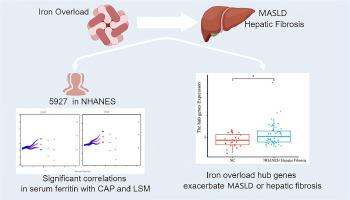流行病学和转录组数据确定了铁超载与代谢功能障碍相关的脂肪肝和肝纤维化之间的联系。
IF 3.1
3区 医学
Q2 NUTRITION & DIETETICS
引用次数: 0
摘要
本研究的主要目的是探讨铁超载(IO)、代谢功能障碍相关性脂肪性肝病(MASLD)和肝纤维化之间的关联。我们假设两者之间存在显著关联。我们分析了 NHANES(2017-2020 年)的数据,以探讨 IO 对美国成年人 MASLD 和肝纤维化的影响。我们评估了血清铁蛋白、受控衰减参数(CAP)、肝脏硬度测量(LSM)和各种协变量。基因表达数据来自 FerrDb V2 和 GEO 数据库。研究人员进行了差异基因表达分析、蛋白质-蛋白质相互作用(PPI)网络构建、基因本体(GO)和 KEGG 通路富集分析。研究验证了 MASLD、肝纤维化和铁超载枢纽基因之间的联系。这项针对 5927 名参与者(平均年龄 46.78 岁)的研究显示,在调整协变量后,血清铁蛋白与 CAP、LSM 之间存在显著相关性。阈值效应分析表明,血清铁蛋白与 CAP、LSM 之间存在非线性关联,不同年龄和性别的人之间的关联模式各不相同。此外,血清铁蛋白与 MASLD 和肝纤维化的 ROC 曲线下面积分别为 0.8272 和 0.8376,显示了其在评估这些情况时的性能。此外,分子分析还发现了与铁超载、MASLD 和肝纤维化相关的潜在枢纽基因,揭示了其潜在机制。我们的研究结果揭示了铁超载、MASLD 和肝纤维化之间的关联。此外,枢纽基因可能与铁超载有关,并随后导致 MASLD 和肝纤维化的进展。这些发现为精准营养策略提供了支持。本文章由计算机程序翻译,如有差异,请以英文原文为准。

Epidemiological and transcriptome data identify association between iron overload and metabolic dysfunction-associated steatotic liver disease and hepatic fibrosis
The primary objective of this study was to examine the association between iron overload (IO), metabolic dysfunction-associated steatotic liver disease (MASLD), and hepatic fibrosis. We hypothesized that there is a significant association. Data from the NHANES (2017-2020) were analyzed to explore IO's impact on MASLD and hepatic fibrosis in U.S. adults. We assessed serum ferritin, controlled attenuation parameter (CAP), liver stiffness measurement (LSM), and various covariates. Gene expression data were sourced from the FerrDb V2 and GEO databases. Differential gene expression analysis, Protein-Protein Interaction (PPI) Network construction, and Gene Ontology (GO) and KEGG pathway enrichment analyses were performed. The study verified the link between MASLD, hepatic fibrosis, and iron overload hub genes. This study of 5927 participants, averaging 46.78 years of age, revealed significant correlations between serum ferritin and CAP, LSM, after adjusting for covariates. Threshold effect analysis indicated nonlinear associations between serum ferritin and CAP, LSM, with distinct patterns observed by age and gender. Moreover, the area under the ROC curve for serum ferritin with MASLD and hepatic fibrosis was 0.8272 and 0.8376, respectively, demonstrating its performance in assessing these conditions. Additionally, molecular analyses identified potential hub genes associated with iron overload and MASLD, and hepatic fibrosis, revealing the underlying mechanisms. Our study findings reveal an association between iron overload, MASLD, and hepatic fibrosis. Additionally, the hub genes may be implicated in iron overload and subsequently contribute to the progression of MASLD and hepatic fibrosis. These findings support precision nutrition strategies.
求助全文
通过发布文献求助,成功后即可免费获取论文全文。
去求助
来源期刊

Nutrition Research
医学-营养学
CiteScore
7.60
自引率
2.20%
发文量
107
审稿时长
58 days
期刊介绍:
Nutrition Research publishes original research articles, communications, and reviews on basic and applied nutrition. The mission of Nutrition Research is to serve as the journal for global communication of nutrition and life sciences research on diet and health. The field of nutrition sciences includes, but is not limited to, the study of nutrients during growth, reproduction, aging, health, and disease.
Articles covering basic and applied research on all aspects of nutrition sciences are encouraged, including: nutritional biochemistry and metabolism; metabolomics, nutrient gene interactions; nutrient requirements for health; nutrition and disease; digestion and absorption; nutritional anthropology; epidemiology; the influence of socioeconomic and cultural factors on nutrition of the individual and the community; the impact of nutrient intake on disease response and behavior; the consequences of nutritional deficiency on growth and development, endocrine and nervous systems, and immunity; nutrition and gut microbiota; food intolerance and allergy; nutrient drug interactions; nutrition and aging; nutrition and cancer; obesity; diabetes; and intervention programs.
 求助内容:
求助内容: 应助结果提醒方式:
应助结果提醒方式:


